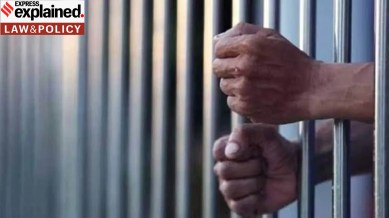Electronic tracking of undertrials on bail: benefits and challenges
What are the benefits of electronic tracking of people out of prison on bail? What are the lessons from other countries?

On November 5, President Droupadi Murmu released a report titled “Prisons in India: Mapping Prison Manuals and Measures for Reformation and Decongestion”. The report, authored by the Supreme Court’s Centre for Research and Planning, suggests a variety of measures to address overcrowding in prisons, including a section titled “Electronic Tracking of Prisoners”.
Though the court itself in July held in strong terms that bail conditions that allow the police to track the movement of an accused would violate the right to privacy, the report and other authorities, including the Law Commission of India and the Parliamentary Standing Committee on Home Affairs, suggest that tracking would be beneficial with the right guardrails.
What are the benefits to electronic tracking, and what are the challenges?
A cost-effective alternative to incarceration
According to statistics by the National Crime Records Bureau (NCRB), prisons in India suffer from significant overpopulation with a 131.4% occupancy rate as of December 2022 — 5,73,220 inmates in comparison to a total capacity of 4,36,266 in jails across India. In addition, 75.8% of prisoners in India are undertrials. The Prisons in India report suggests that electronic monitoring “could prove to be a cost-effective method to decongest jails in India”.
The report cites statistics from Odisha where the state government spends roughly Rs 1 lakh annually on a single undertrial prisoner. A tracker “would cost around Rs 10,000 to 15,000”, the report says. In 2023, a Parliamentary Standing Committee on Home Affairs submitted a report titled “Prisons – Conditions, Infrastructure and Reforms”, which spoke about the potential benefits of electronic tracking using ankle or bracelet trackers.
It states, “Through the use of these kinds of trackers, administrative machinery or human resources staff involved in keeping track of prisoners who are out on bail can be reduced and it could be a cost-effective method for keeping track of such prisoner without the involvement of large administrative staff strength”.
Lessons from the US: the drawbacks of electronic monitoring
However, some studies claim that electronic monitoring simply amounts to incarceration by a different name, often referred to as ‘e-carceration’. In the United States of America, where electronic monitoring and movement restrictions for persons on parole or in the pre-trial stage is a widespread practice, the American Civil Liberties Union (ACLU) published a report titled “Rethinking Electronic Monitoring: A Harm Reduction Guide”.
In the report, they claim that “EM serves as an extension of the carceral crisis, expanding the punitive power of jails and prisons beyond their traditional physical walls as a system of “e-carceration”…overuse of government surveillance can create oppressive, criminalizing environments, especially for communities of color”.
A broad comparison can be drawn with India where, like communities of colour in the US, people from Scheduled Castes, Scheduled Tribes and Other Backward Classes backgrounds are overrepresented in prison populations. The latest NCRB data shows that 68.4% of prisoners belong to SC, ST and OBC communities.
There is also the question of who will bear the costs when it comes to electronic monitoring. The Supreme Court’s report suggests that it would be the government, but in jurisdictions such as the US (which has been cited as an example in the court’s report), the costs are often borne by the individual being monitored and include daily charges of $3-$35 along with $100-$200 in setup charges according to the non-profit Electronic Frontier Foundation.
There is also the possibility of stigma that comes with visible ankle or bracelet devices, a concern acknowledged by the Prisons in India report, stating “Some individuals may resist wearing tracking devices due to concerns about social stigma or a perception of invasive surveillance”.
The ACLU in a piece titled “Three People Share How Ankle Monitoring Devices Fail, Harm, and Stigmatize” note that “the stigma, social isolation, and stress that results from being monitored exacerbates depression and anxiety for wearers”.
Privacy and electronic tracking
On July 8, a Bench of Justices Abhay S Oka and Ujjal Bhuyan struck down an unusual bail condition imposed by the Delhi High Court on two foreign nationals booked for offences under the Narcotic Drugs and Psychotropic Substances Act, 1985. The Delhi HC granted bail to the accused persons and ordered that they must “drop a PIN on the google map to ensure that their location is available to the Investigation Officer of the case”.
The court held that such a condition would violate the fundamental right to privacy under Article 21, stating that “The investigating agency cannot be permitted to continuously peep into the private life of the accused enlarged on bail”. The court then deleted this bail condition.
The Parliamentary Standing Committee in 2023, while advocating for the cost benefits of electronic monitoring, noted that such measures must only be taken with the consent of the inmate in question. “At the same time, it must be ensured that to avoid any kind of human rights violation this scheme or method should be used on voluntary basis after procuring the consent of inmates”.
A team of law students and Prof. Kate Weisburd from George Washington University studied the impact of electronic monitoring on privacy by analysing policies governing electronic monitoring across 44 states in the United States of America. Their report states that “People on court supervision (including those who are on monitors) are often subjected to invasions of their bodily autonomy through random drug testing, blood and DNA sampling, as well as invasions of their home through mandatory home visits that may include warrantless searches of the home”.
The 268th Law Commission report acknowledges the “grave and significant impact on constitutional rights” that such a measure might have. It suggests that such monitoring “must be used only in grave and heinous crimes, where the accused person has a prior conviction in similar offences” and states that criminal legislations should be amended accordingly.